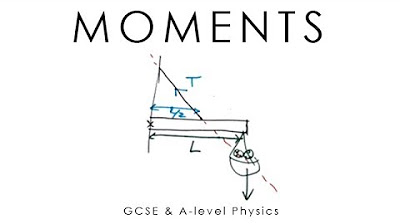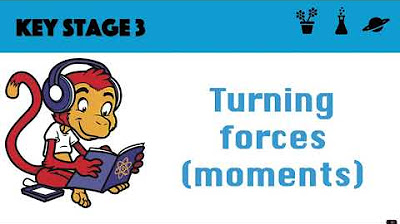Cambridge IGCSE Physics | 1.20 Turning Effect | GCSE | O Levels | My Second Teacher
TLDRThe video script explores the mechanics of a seesaw, emphasizing the roles of the lever and pivot. It clarifies that the seesaw's movement is influenced by the distribution of weight relative to the pivot. The script explains that a heavier person should sit closer to the pivot, while a lighter person should sit further away to achieve balance. It also introduces the concept of the moment of force, which is the turning effect caused by a force applied at a distance from the pivot, crucial for understanding the seesaw's dynamics.
Takeaways
- 😀 A seesaw consists of two main parts: a lever and a pivot.
- 👫 The seesaw operates on the principle of balance, with one person sitting closer to the pivot and the other further away depending on their weight.
- 🔄 The pivot is the central point to which the lever is attached and is also fixed to the ground.
- ⚖️ The heavier person should sit closer to the pivot, and the lighter person should sit further away to achieve balance.
- 🌐 The seesaw moves up and down due to the rotation caused by the force exerted at a distance from the pivot.
- 📉 Sitting closer to the edge of the seesaw makes it easier and faster to bring it down to the ground compared to sitting near the pivot.
- 🔢 Weight is a type of force that can be calculated using the equation: weight = mass × gravitational acceleration.
- 🌀 The turning effect caused by a force at a distance from the pivot is known as the moment of force.
- 📚 The concept of the moment of force is important and may be tested in exams.
- 🔄 The seesaw's rotation is not caused by the pivot itself but by the weight's distance from the pivot.
- 🎯 When sitting directly above the pivot, there is no turning effect because the force is applied at the pivot point.
Q & A
What are the two main parts of a seesaw?
-The two main parts of a seesaw are the lever and the pivot.
Why should the lighter person sit further back on the seesaw?
-The lighter person should sit further back to balance the weight of the heavier person who sits nearer to the pivot, creating a balanced rotation around the pivot.
What is the pivot in the context of a seesaw?
-The pivot is the central point around which the seesaw rotates, and it is fixed to the lever and the ground.
Why does the seesaw move differently when someone sits at the edge compared to the center?
-When someone sits at the edge, their weight is not directly above the pivot, causing the seesaw to rotate. When sitting at the center, the weight is directly above the pivot, resulting in no rotation.
What is the relationship between weight and force?
-Weight is a special type of force that can be calculated by multiplying mass by gravitational acceleration.
Why does the seesaw move more easily when someone is seated nearer to the edge?
-It is easier to bring the seesaw down to the ground when seated nearer to the edge because the moment of force is greater, causing a larger turning effect.
What is the moment of force?
-The moment of force is the turning effect produced by a force acting at a distance from the pivot. It is also known as torque.
How does the position of a person on the seesaw affect its rotation?
-The position affects the rotation because the further the person is from the pivot, the greater the moment of force and the more the seesaw will rotate.
What would happen if two people of equal mass sit on opposite ends of the seesaw?
-If two people of equal mass sit on opposite ends, the seesaw would balance horizontally because the moments of force on both sides would be equal.
Can you explain the concept of the moment of force in simple terms?
-The moment of force can be thought of as how effectively a force can cause an object to rotate. It depends on both the magnitude of the force and the distance from the pivot.
Why is it important to understand the concept of the moment of force in the context of a seesaw?
-Understanding the moment of force helps explain why different positions on a seesaw result in different rotational movements, which is crucial for balancing and operating the seesaw effectively.
Outlines
🎢 Understanding the Seesaw Mechanics
This paragraph delves into the basic components of a seesaw, which are the lever and the pivot. It explains how the seesaw operates with a person sitting at different distances from the pivot. The discussion highlights the concept of balance, with the heavier person sitting closer to the pivot and the lighter person further away to achieve equilibrium. It also touches on the physics involved, such as weight being a force calculated by mass times gravitational acceleration, and the seesaw's movement being influenced by the pivot point, causing rotation rather than linear motion. The paragraph introduces the concept of the moment of force, which is the turning effect created by a force exerted at a distance from the pivot.
Mindmap
Keywords
💡Seesaw
💡Pivot
💡Lever
💡Balance
💡Mass
💡Gravitational Acceleration
💡Weight
💡Moment of Force
💡Rotation
💡Distance
💡Edge
Highlights
A seesaw consists of two main parts: a lever and a pivot.
The seesaw's movement is based on the principle of balance between two forces.
The pivot is the point where the lever is fixed to the ground.
To balance a seesaw, the person with more mass should sit closer to the pivot.
The lighter person should sit further from the pivot to balance the seesaw.
The seesaw's movement is not linear but rotational due to the pivot.
The effect of weight on the seesaw depends on its distance from the pivot.
Weight is a type of force that can be calculated by mass times gravitational acceleration.
Despite the same force, the seesaw's movement differs based on the position relative to the pivot.
When seated near the edge, it's easier to bring the seesaw down due to the leverage.
The seesaw's rotation is caused by the moment of force, not directly by the pivot.
The moment of force is the turning effect created by a force at a distance from the pivot.
When sitting directly above the pivot, there is no turning effect due to the force's position.
Understanding the moment of force is crucial and may be tested in exams.
The seesaw demonstrates fundamental principles of physics, such as balance and leverage.
The seesaw's operation is an example of how weight distribution affects mechanical systems.
The dialogue provides a practical explanation of physics concepts related to seesaws.
Transcripts
Browse More Related Video

Moments, Torque, Toppling & Couples - GCSE & A-level Physics (full version)

Turning Forces (Moments)

GCSE Physics - Moments - Gears and Levers #47

GCSE Physics - How Moments Work - Spanners and Seesaws #46

The Role of Moment of Force in Daily Life - Everyday Physics

Physics 15 Torque (14 of 27) Body Mechanics: Ex. 2, F=? To Lift Dumbbell
5.0 / 5 (0 votes)
Thanks for rating: